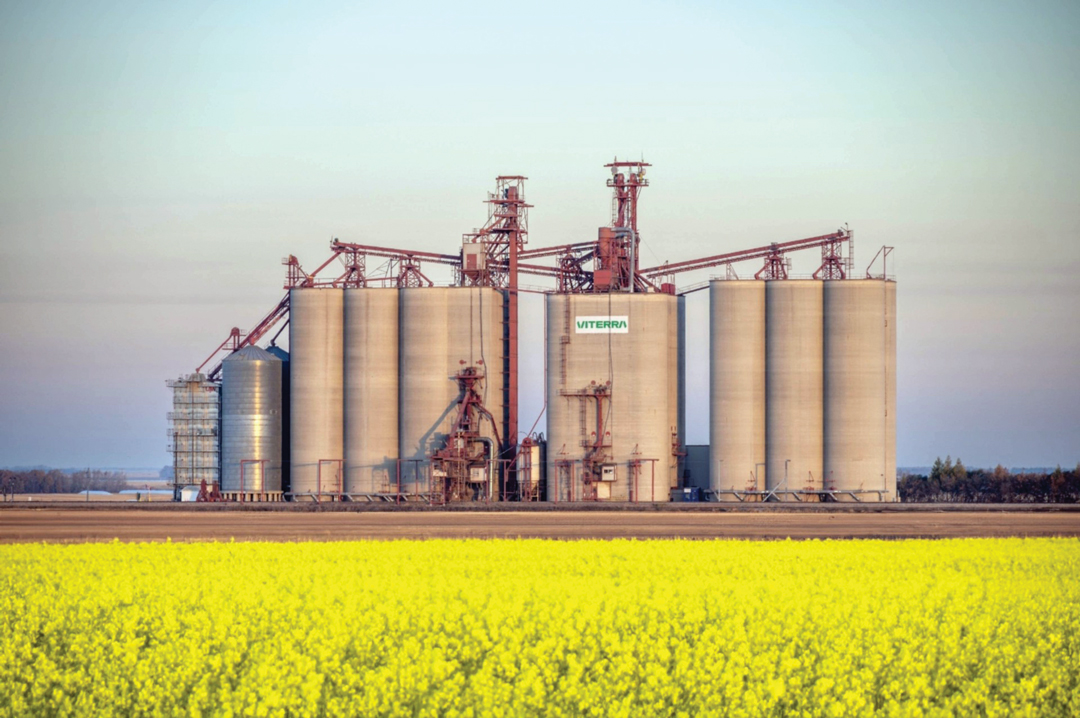ON THE VERGE OF A MERGE
BY GEOFF GEDDES
While there’s no Tinder for business, Bunge and Viterra hope they’ve found the perfect match. The two companies announced their intent to merge in June 2023. Viterra brings more than 80 Canadian grain-handling centres to the blossoming relationship, along with sales to more than 70 nations. For its part, Bunge is the world’s largest processor of oilseeds, with 300 operations in 40 countries. Of course, with a celebrity wedding comes major scrutiny.
In addition to reviews by regulators in the U.S., Transport Canada is conducting a public interest assessment that must be complete by June 2, while the Competition Bureau will also scrutinize the agreement. “Viterra has a long history in Canada and is one of our largest grain handlers,” said Shannon Sereda, director, government relations, policy and markets for Alberta Grains. The proposal includes Bunge buying a 70 per cent stake in Viterra, at a total price of around $34 billion. “It’s a massive deal,” said Sereda. “We see this as continued consolidation in agriculture. Bunge is more focused on oilseed production, whereas Viterra is a major grain buyer at the elevator level. From a wheat and barley perspective, we are looking more at Viterra’s operation and the impact of a merger on those elevator facilities, as that’s where our farmers sell their grain.”
Such corporate consolidation in agriculture always sparks concern about competition. “Mergers like this can mean fewer marketing options for farmers,” said Sereda. “If it increases the distance to market, that can raise costs for the farmer, thereby reducing competitiveness and profitability.”
Jon Driedger is vice-president of LeftField Commodity Research in Hanover, MB. He shares these concerns.
BRACE FOR IMPACT
“I think the impact on competition is the main worry for growers, and not knowing what that impact will be,” said Driedger. “Those who favour the merger point out that Viterra is mainly an exporter handling a range of crops, and Bunge is a domestic crusher that primarily buys canola. In many respects, their businesses don’t overlap the way they would if Richardson and Cargill merged, for example.”
As well, a larger company may have more efficiencies and greater access to capital, leading to more investment in the crop sector. “If I was Viterra or Bunge, that’s certainly how I would frame it,” said Driedger. “Whether enhancements to efficiency and available capital will spawn benefits that trickle down to farmers or industry in Western Canada is another question.” The effects of the merger may vary from region to region in the West.
TIMING AND COMPETITION
“If it’s an area where you have a Bunge crush plant and two elevators—one belonging to Viterra and one to a third company—losing an elevator could be significant, because you’re going from three buyers to two,” said Driedger. “With a space containing many active buyers, the impact may be more muted.” Timing may also play a role. Where there is less competition, this might not be as noticeable when business is good and the volume of crop movement is substantial.
Wayne Schneider farms 1,800 acres of canola, barley, wheat and pulses in Nisku, and serves as a director on the board of the Alberta Canola Producers Commission.
“Right now, Viterra and Bunge both own canola crushing facilities in Manitoba that are 75 kilometres apart,” said Schneider. “After the merger, will they still run both operations, or will one location be divested? If one is closed, it will mean more logistical challenges and greater transportation costs for those nearby farms.”
ROUGH SEAS AHEAD?
There may also be ramifications for ports, as Bunge holds a stake in 10 Canadian port export facilities located between Montreal and Vancouver. “If Bunge plans to maintain or increase their export activity, that works out well for us,” said Schneider. “If not, and they shut down some of those facilities, that may force us to reduce our exports.”
Farmers like Schneider also see potential for vertical integration between the two companies, right from buying the grain to value-added processes. “More value-added products could mean greater revenue for Canada as a whole, but as farmers, we haven’t been privy to the plans until now,” he said. “Historically, no one seems to take growers into account with deals like this; we’re just told where to go and what to do.”
Recent meetings between the crop commissions, government and the two corporations have taken some of the edge off this sense of exclusion. “We [Alberta Canola] have met with the Competition Bureau and with representatives of Viterra and Bunge, and they heard what we had to say,” said Schneider. “We are glad to be part of the process and to have a voice in the future of agribusiness.”
As the situation continues to evolve, Alberta Grains has spoken with Bunge and Viterra as well to discuss the deal and the perspectives of the two corporations. “Both companies say their businesses are complementary,” said Sereda. “Bunge has a large global reach and supply chain created through its canola crushing and oilseed production. As its contribution, Viterra brings a well-established organization with substantial grain buying capacity. The two parties feel this could create market opportunities for farmers who can leverage Bunge’s global access.” This international reach includes Bunge’s 25 per cent share in G3, a grain business based in Winnipeg. In addition to the operation of numerous grain elevators in Western Canada and port terminals down east, G3 owns a grain export terminal at the Port of Vancouver.
“Now, instead of just dealing with the Bunge-Viterra footprint, we are looking at a Bunge-Viterra-G3 footprint,” said Sereda. “We have G3 elevators across Alberta, so that’s another thing to consider.”
EYES ON THE PRIZE
Given the stakes, Sereda is pleased by Ottawa’s diligence in assessing the merger proposal and the possible repercussions of the deal. “Transport Canada has really focused on port facilities and launched a public good assessment under the authority of the Canada Transportation Act to evaluate the post-merger landscape,” said Sereda.
Because port operations are so critical for the movement of grain and many other goods, especially in Western Canada, Transport Canada will assess the potential impact of the deal on this movement and the Canadian economy. “We are very interested in what the assessment may uncover, and we are collaborating with other groups to study the implications in more detail,” said Sereda.
While this is not the first merger to involve major grain companies, the magnitude of the deal sets it apart. “With most such agreements in the past, they involved two companies in a similar line of business, like when the Saskatchewan Wheat Pool merged with United Grain Growers [UGG],” said Driedger. “If you compare that to the current proposal, it’s not exactly apples to apples.”
Although the evaluation by Transport Canada closed on Dec. 22, 2023, Alberta Grains continues to work with fellow commodity groups that have been asked to study the deal. If all goes as envisioned by Bunge and Viterra, the merger should be completed by mid-2024. The corporate matchmaking process may be slower than a typical dating app connection, but a lot rides on its outcome.







Comments